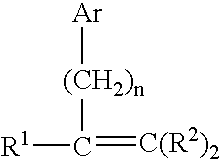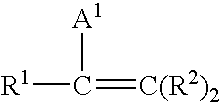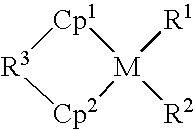Substantially random interpolymer grafted witn one or more olefinically unsaturated organic monomers
- Summary
- Abstract
- Description
- Claims
- Application Information
AI Technical Summary
Benefits of technology
Problems solved by technology
Method used
Image
Examples
example 1
[0183] Production of Ethylene-Styrene Interpolymer Grafts: The ethylene-styrene interpolymers were prepared as described in U.S. Pat. No. 5,703,187 and also in U.S. application Ser. No. 09 / 488,220, filed Jan. 19, 2000 and are available from the Dow Chemical Company.
[0184] The grafted samples were prepared by feeding a mixture of polymer, reactive monomer and initiator into a Werner-Pfleiderer ZSK 30 twin screw extruder. The reactive monomer was maleic anhydride, the initiator was 2,5-dimethyl-2,5-di(t-butylperoxy)hexane, the polymers were Ethylene Styrene Interpolymers with different styrene content (30 wt %, 70 wt %) and with different melt index (1 g / 10 min and 10 g / 10 min). The weight ratio of MAH / initiator / polymer was 1.5 / 0.05 / 98.45%.
[0185] The operating conditions of the twin screw extruder were:
2 Barrel Temp. (1-5, Die) 80.degree. C., 150.degree. C., 200.degree. C., 200.degree. C., 150.degree. C., 150.degree. C. Melt Temp. (4) 210.degree. C. Melt Temp. (Die) 150.degree. C. Scr...
example 2
[0189] 1) Preparation of Interpolymers
[0190] Substantially random ethylene / styrene interpolymer (ESI) no.7 and substantially random ethylene / propylene / styrene interpolyer (EPS) no. 1 were prepared in a continuously operating loop reactor. An Ingersoll-Dresser twin screw pump provided the mixing. The reactor ran liquid full at 475 psig (3,275 kPa). Raw materials and catalyst / cocatalyst flows were fed into the reactor through injectors and Kenics static mixers in the loop reactor piping. From the discharge of the loop pump, the process flow went through two shell and tube heat exchangers before returning to the suction of the loop pump. Upon exiting the last exchanger, loop flow returned through the injectors and static mixers to the suction of the pump. A second monomer / feed injector and mixer were used if available. Heat transfer oil or tempered water was circulated through the exchangers' jacket to control the loop temperature. The exit stream of the loop reactor was taken off betw...
PUM
| Property | Measurement | Unit |
|---|---|---|
| Angle | aaaaa | aaaaa |
| Temperature | aaaaa | aaaaa |
| Temperature | aaaaa | aaaaa |
Abstract
Description
Claims
Application Information
 Login to View More
Login to View More - R&D
- Intellectual Property
- Life Sciences
- Materials
- Tech Scout
- Unparalleled Data Quality
- Higher Quality Content
- 60% Fewer Hallucinations
Browse by: Latest US Patents, China's latest patents, Technical Efficacy Thesaurus, Application Domain, Technology Topic, Popular Technical Reports.
© 2025 PatSnap. All rights reserved.Legal|Privacy policy|Modern Slavery Act Transparency Statement|Sitemap|About US| Contact US: help@patsnap.com



